
The Gymnotiformes are an order of teleost bony fishes commonly known as Neotropical knifefish or South American knifefish. They have long bodies and swim using undulations of their elongated anal fin. Found almost exclusively in fresh water, these mostly nocturnal fish are capable of producing electric fields to detect prey, for navigation, communication, and, in the case of the electric eel, attack and defense. A few species are familiar to the aquarium trade, such as the black ghost knifefish, the glass knifefish, and the banded knifefish.

Osteoglossiformes is a relatively primitive order of ray-finned fish that contains two sub-orders, the Osteoglossoidei and the Notopteroidei. All of at least 245 living species inhabit freshwater. They are found in South America, Africa, Australia and southern Asia, having first evolved in Gondwana before that continent broke up. In 2008, several new species of marine osteoglossiforms were described from the Danish Eocene Fur Formation, dramatically increasing the diversity of this group. This implies that the Osteoglossomorpha is not a primary freshwater fish group with the osteoglossiforms having a typical Gondwana distribution.
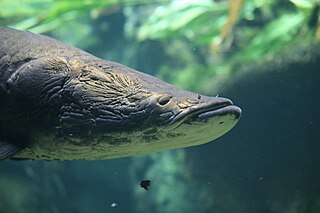
Osteoglossomorpha is a group of bony fish in the Teleostei.

Electroreception and electrogenesis are the closely related biological abilities to perceive electrical stimuli and to generate electric fields. Both are used to locate prey; stronger electric discharges are used in a few groups of fishes to stun prey. The capabilities are found almost exclusively in aquatic or amphibious animals, since water is a much better conductor of electricity than air. In passive electrolocation, objects such as prey are detected by sensing the electric fields they create. In active electrolocation, fish generate a weak electric field and sense the different distortions of that field created by objects that conduct or resist electricity. Active electrolocation is practised by two groups of weakly electric fish, the Gymnotiformes (knifefishes) and the Mormyridae (elephantfishes), and by Gymnarchus niloticus, the African knifefish. An electric fish generates an electric field using an electric organ, modified from muscles in its tail. The field is called weak if it is only enough to detect prey, and strong if it is powerful enough to stun or kill. The field may be in brief pulses, as in the elephantfishes, or a continuous wave, as in the knifefishes. Some strongly electric fish, such as the electric eel, locate prey by generating a weak electric field, and then discharge their electric organs strongly to stun the prey; other strongly electric fish, such as the electric ray, electrolocate passively. The stargazers are unique in being strongly electric but not using electrolocation.

The Mormyridae, sometimes called "elephantfish", are a superfamily of weakly electric fish in the order Osteoglossiformes native to Africa. It is by far the largest family in the order, with around 200 species. Members of the family can be popular, if challenging, aquarium species. These fish have a large brain size and unusually high intelligence.

Marcusenius is a genus of the elephantfish group native to Africa. Its members are highly diverse in size, with the smallest species reaching less than 15 cm (6 in) and the largest more than 1 m (3.3 ft).

Pollimyrus is a genus of elephantfishes native to Africa.
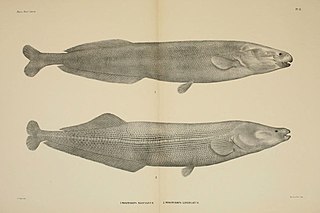
Mormyrops is a genus of weakly electric fish in the family Mormyridae from freshwater in Africa. They are characterized by an elongate head measuring twice as long as high, and no teeth on the palate or the tongue. The genus includes the largest member of the mormyrid family, the cornish jack at up to 1.5 m (4.9 ft) in length.

The subfamily Mormyrinae contains all but one of the genera of the African freshwater fish family Mormyridae in the order Osteoglossiformes. They are often called elephantfish due to a long protrusion below their mouths used to detect buried invertebrates that is suggestive of a tusk or trunk. They can also be called tapirfish.

Boulengeromyrus is a monospecific genus of freshwater ray-finned fish belonging to the family Mormyridae, the elephantfishes. The only species in the genus is Knoepffler's elephantfish. It occurs only in the Ivindo River and the Ntem River basins of Gabon and Cameroon. It reaches a maximum length of about 41 cm (16 in).
Brienomyrus is a genus of small elephantfish in the family Mormyridae from Africa. Usually available in the pet trade, these fish are commercially referred to as baby whales or baby whalefish.
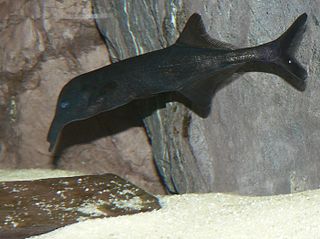
Campylomormyrus is a genus of elephantfish in the family Mormyridae.
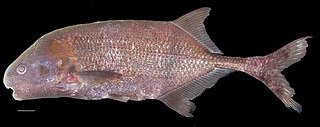
Ivindomyrus opdenboschi is a species of elephantfish in the family Mormyridae. It is only found in the Ivindo River in Gabon. It reaches a length of about 27.4 cm (10.8 in).

Myomyrus is a genus of elephantfish in the family Mormyridae. Its members reach about 25–30 cm (10–12 in) in length and are restricted to the Congo River Basin in Africa.

Paramormyrops is a genus of elephantfish in the family Mormyridae from Africa.
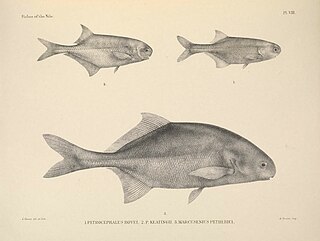
Petrocephalus is a genus of ray-finned fish in the family Mormyridae. All the fish species of this genus are endemic to Africa.
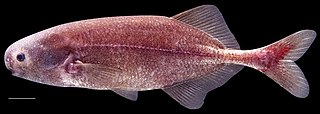
Stomatorhinus is a genus of small elephantfish in the family Mormyridae.

Petrocephalus boboto is a species of electric fish in the genus Petrocephalus. It is so far only known from the holotype collected from Congo River at Yangambi, the Democratic Republic of the Congo. The specific name boboto is Lingala word for "peace".

Petrocephalus arnegardi is a species of electric fish in the genus Petrocephalus native to the Central Congo River basin. It is found in middle Congo River and in the Likouala River drainage, in the Democratic Republic of the Congo and Republic of the Congo. It is named after Matthew Arnegard, an expert on elephantfishes.

The Mormyroidea are a superfamily of fresh water fishes endemic to Africa that, together with the families Hiodontidae, Osteoglossidae, Pantodontidae and Notopteridae, represents one of the main groups of living Osteoglossiformes. They stand out for their use of weak electric fields, which they use to orient themselves, reproduce, feed, and communicate.





















